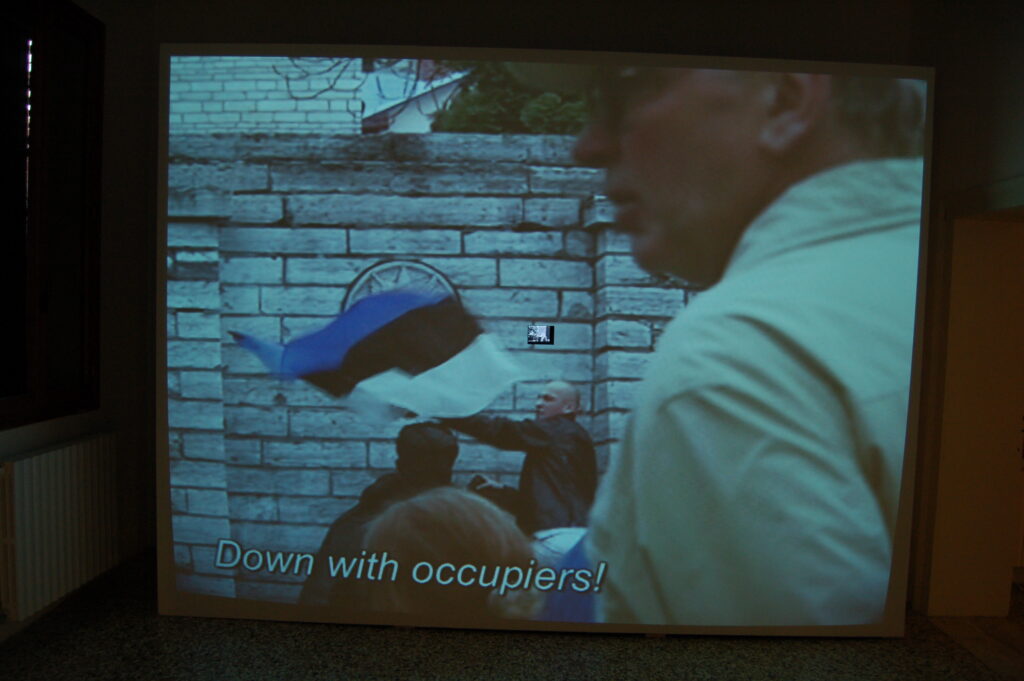
Kristina Norman’s project After-War represented Estonia at the 53rd Venice Biennale (07.06 – 22.11.2009). The exhibition was curated by Marco Laimre.
In April 2007, the Government of Estonia removed the monument dedicated to the Soviet soldiers fallen in the Great Patriotic War (aka Second World War) that had stood in the centre of Tallinn since 1947. The official name of the Bronze Soldier was the Monument to the Liberators of Tallinn and most Estonian citizens considered it a symbol of Soviet occupation. It was re-erected 2.5 kilometres from its original location in a military cemetery. The previous location was planted with bushes and flowers as if nothing had been there before. This psycho-geographical offset by the Estonian Government resulted in protests by the Russian-speaking citizens that culminated in two days of mass rioting on the streets of Tallinn. Kristina Norman uses the term “memory community” to describe the event, to analyse it and to propose subsequent cultural practices. The title After-War indicates a situation where the war itself has ended but the conflict continues.
The author of the Estonian exhibition at the 53rd Venice Biennale, Kristina Norman is part of the generation of artists who joined the art world in the first decade of the new millennium. She works with political, provocative, documentary and research-based art. Norman’s oeuvre is exceedingly contextual and is born out of the relationship with her surrounding environment. After-War is a complete installative setting consisting of videos, photos and objects that is formed of five different spaces. The work is based on an event that must be considered one of the most traumatic and the most discussed in the time after Estonia re-gained its independence.
Kristina Norman: “My artistic practice is interwoven with a documentary approach and the video camera is a tool that I cannot be without. I collect material and information for my art projects while making documentaries and vice versa. The installation After-War is, in a way, socio-cultural research and an experiment that helps me to map and to digest the ‘case of the monument’. I am captivated by the way values are created and the problems of the sacred and the profane. I am also interested in the relationship between memory and history in constructing the national and state-based identity.”
The exhibition was accompanied by a collection of texts illustrated by the artist. It contains articles and essays about the monument conflict and the project After-War by the philosopher and teacher of international relations at the Central European University Alexander Astrov, cultural theoretician Airi Triisberg, architectural theoretician Andres Kurg, curator Marco Laimre and artist Kristina Norman.
Kristina Norman was born in Tallinn in 1979 where she still lives and works. She has studied in the Estonian Academy of Arts and has worked there as a teacher. Norman is currently making a full-length documentary about the authors of the memorials for the Estonian War of Independence. She has participated in international exhibitions and festivals since 2006: that year she represented Estonia in the Modern Art Oxford Gallery program Arrivals > Art from the New Europewith the documentary Pribalts; in 2007, she participated in the Biennale of Young Artists in Tallinn with her experimental documentary Monolith; and in 2008, she participated in the fifth Berlin Biennale for Contemporary Art with her pseudo-documentary The Field of Genius.
Marco Laimre was born in 1968. He has been active as an artist and a curator since 1994. Since 2005, he is a professor of photography at the Estonian Academy of Art and since 2006, he is on the board of the Contemporary Art Museum of Estonia.
Exhibition team
Artist Kristina Norman
Curator Marco Laimre
Commissioner Johannes Saar (CCA)
Vice-commissioner Elin Kard (CCA)
Team: Art Allmägi, Andres Amos, Andris Brinkmanis, Edith Karlson, Jass Kaselaan, Raul Keller, Meelis Muhu, Jaak Soans, Taivo Timmusk, Reimo Võsa-Tangsoo
The exhibition project was chosen after an open competition. It was selected by the jury Mika Hannula, Sirje Helme, Anders Härm, Lars Bang Larsen, Kai Lobjakas, Reet Mark, Marko Mäetamm, Johannes Saar and Helene Tedre.